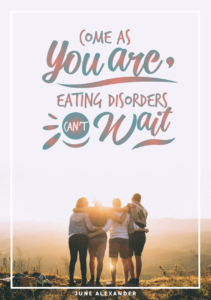The tragic cost when Dad has an eating disorder and his child does too

The tragic cost when Dad has an eating disorder and his child does too
Immersion in the skewed messages of diet culture makes children vulnerable to eating disorders. From childhood, for more than 44 years, Ruth did “what Dad did”. She fasted, and severely restricted some foods. The cost was great. Read Ruth’s story.
Prior to my father’s death in August 2013, I was 52 years old, and at a crossroads. I could follow Dad’s life trajectory, as I had unwittingly done for years, or continue on a recovery path on which I was taking hesitant steps. Dad’s ravaged, emaciated body was living testimony to the devastation awaiting if I chose his path.
In January that year, Dad, who had metastatic prostate cancer, greeted me at the door to his New Zealand home one day by stripping off his tee shirt and dropping a double bicep, saying: “I lost 30kg, don’t I look great?” He was skeletal, hunched, his large boned frame visible through greying skin. He had lost the weight by fasting for prolonged periods, having been diagnosed with a slow form of prostate cancer some years previously.
Dad was ‘ahead of his time’
Ironically, to “prevent cancer”, Dad had started fasting in 1969 when he embarked on what is now termed an orthorexic diet. He had fasted many times since: on coffee, hot chocolate, fruit juice, potassium broths, water with copious amounts of salt added, and soda. He sometimes forbade the family, including my mother, from eating things that contained sugar (this was the 1960s – he was ahead of his time).
He purchased huge boxes of green leafy vegetables and carrots, juicing with abandon; he baked his own bread with organic flour. He regularly denounced many different foods as poison, cleaning out cupboards and fridge with complete abandon, even if it meant no food was left in the house. Other times he ate almost every bit of food and left none for Mum, my sister, or me. Our small family was so inured to his weird eating that we never questioned it. When diagnosed with cancer, he repeatedly embarked on a severely restrictive eating plan, including fasting, convinced that he could “beat it”.
I thought that I was doing it ‘right’
That was just “what Dad did”. It was what I did too. But, until the year of his death, I thought that unlike Dad, I was doing it “right”. I believed that unlike Dad, I had achieved a “balanced, clean” eating regime. While Dad weight cycled and struggled with a high weight, I saw my thin body, disciplined eating, and exercise as proof that I had conquered MY food and weight demons. The year Dad died, I competed in a fat burning, muscle building competition, and wrote a euphoric post in the group forum about how I FINALLY had my eating under control.
Dad was hospitalised five times in his last year for “refeeding syndrome”. Because of his extreme dietary behaviours, and the savage weight loss combined with the ravages of cancer, his body was unable to keep his electrolytes in balance. The final time, he lost the use of his legs and was told he would not be able to drive again. He opted for aggressive palliative care, as close to voluntary euthanasia as you can get in New Zealand and died a week later.
Some weeks before, a close family member who was in recovery from ED, had directed me to a blog post that shattered my perception of the way I ate and exercised, ripping the veneer from my socially normative “healthy lifestyle”. Until then I had believed that all I needed to do was find a perfect balance, so as to manage my inconvenient relationship with food. But now I felt like walls were falling down around me, walls of a reality that was twisted and warped by a brain hard-wired to extreme restriction. I felt almost as if my life had ended. I could not pretend any longer.
Too late for Dad, but NOT too late for me
I came to realise then that, like Dad, although his illness was never formally diagnosed, I had an eating disorder. It was too late for Dad; but NOT too late for me.
My diagnosis at age 53 was Anorexia Nervosa (AN), of the “compulsive exercise and orthorexia” variety. I was shocked to realise that instead of being a “naturally slim, quite chill woman who was disciplined with exercise and highly educated and motivated about nutrition”, I was underweight, malnourished, deeply anxious, and terrified of certain foods.
My fingernails were a mess, my body temperature was low, I had chronic insomnia, my body fat was very low, and my food choices were limited to a narrow range of “safe” ingredients. I had night sweats, tachycardic events and a panic attack was always lurking nearby. Like many people in a state of clinical starvation, I gained weight on a very low-calorie intake, and at time of diagnosis was attempting to lower that intake even further.
ED had ring-fenced and curated my life
Worse, my ability to stay close to and relate to people I loved dearly was severely compromised, because AN is characterised by emotional numbing, along with – for me, a lifelong obsessive fixation on food, weight and health. The neurobiology of AN helped me to function and produce at a high level socially and professionally by a simple but devastating mechanism: as long as I was in a state of extreme calorie restriction, I was insulated from what would otherwise be unrelenting and debilitating anxiety. My life was ring fenced and curated by ED, and it was closing in around me. Unless I chose recovery, ED would precipitate my death just as it had my dad’s.
Before then, I saw myself as having “had” ED (Bulimia Nervosa) until I was 20 and then recovered. I thought I was really good at “managing my body and mind with exercise and healthy eating”. In reality, for more than 44 years, since before I began fasting with Dad and the rest of our family, my life was marked by repeated and prolonged periods of restrictive eating, and disordered levels of physical activity.
Diet culture and weight bias masks eating disorder behaviours
I am not alone in this. In my ED recovery cohort, many older people tell similar stories of returning to a socially desirable weight while staying stuck deep in ED; it is all too easy for diet culture and weight bias to mask disordered eating and exercise behaviours; it is a terrible thing to realise that society richly rewards people who are “successful” at weight-suppression, even though both subclinical and clinical starvation endanger lives, and destroy relationships, careers, and quality of life.
I was 52 when I began to practise remission; I am 58 this year. My story is not one of returning to my old way of life; it is not one of returning to a socially normative body and pattern of exercise designed to suppress the anxiety that is inherent with ED, while also suppressing my weight.
The hard but life-saving road of learning to live without ED
My story is one of remission as practise, and the long tortuously slow process of rewiring neural pathways, by learning and repeating non-ED behaviours, while letting my body settle where it needs to be without interference.
I was physically and emotionally debilitated for the first three years, while struggling to manage overwhelming anxiety; the anxiety was so overwhelming at times that I ended up in an ambulance with severe panic attacks, accompanied by extremely high blood pressure and tachycardia. My digestive system took over four years to return to normal. I had “idiopathic” pain and oedema, causing discomfort that meant I had to rest most days for those three years, and only as I enter my sixth year of remission can I describe myself as having “returned to (a new) normal function”. I was blessed with a GP who is very ED aware, and who has been able to keep a watch on my biomarkers while encouraging me to be patient with my body as it heals.
Giving hope for healing and recovery
As I continue to heal, I am conscious of the havoc that ED wreaks in many lives and want to offer my own story as hope; hope that even after many decades of devastation, healing and recovery, and a way of life not dominated by ED, is possible.
From what I know of Dad’s childhood, ED was definitely present by his adolescent years. He was a harrier – distance runner – and he was passionate about body building from around the age of 17. That was 1951, and likely no one connected his physical transformation with the severe neurobiological disorder that would disfigure his life. I think it is possible that an early trauma may have triggered his highly conflicted eating patterns. There was no moderate intake. It was either extreme hunger, or extreme deprivation with accompanying body loathing and stigmatising himself as a glutton.
Dad’s erratic eating made me insecure about food
I was very picky with food from early on. Today I would probably have been diagnosed with ARFID. I was punished harshly for that, often being forced to eat foods that made me ill, or physically disciplined for eating “the wrong way”. Dad’s erratic eating meant that I was insecure about food; it was not unusual to come home from school to empty cupboards; sometimes if I bought my own food, Dad would take it off me and refuse to let me eat at all if he deemed it unhealthy at that moment. And the rules always changed. Only a very limited number of foods were safe and “approved”.
Fat bodies were maligned in my family
Add to this our membership in a fundamentalist Christian religion, where messages about gluttony being a sin mingled with weight stigma, with the obvious inference being drawn that “fat” people were gluttons, and that it was the right thing to do to abstain from overeating. By the time I had full blown BN, I was able to keep it hidden from my family members. No one saw my erratic behaviour with food as anything unusual given the history of food and eating in our house.
By the time I developed AN, I had an elaborate reward system in place for keeping my body small. My parents would comment about how “trim” I was looking, and pander to my orthorexic behaviours. Fat bodies were maligned in my family, and also in my socio-religious milieu. I was complimented for being “so skinny” and often asked, “how do you do it?”
ED hid in PLAIN SIGHT inside our family, aided and abetted by a fat-phobic, stigmatising society . We weren’t sick; we were “pursuing health”.
What you can do to help children like Dad and me?
- Reclaim and normalise eating
- Dismantle weight stigma
- Stop weighing kids at school
- Stop using BMI as a measure of health
- Abolish weight shaming advertisements from the multi-billion-dollar diet industry
- Educate parents, teachers and healthcare providers about the reality that signs of an eating disorder are often identical with someone “on a diet”.
- Change the education syllabus so that health is not confined to any particular weight
The eating disorder stole Dad’s life
ED shortened my dad’s life. But before that, it stole the full life he should have been enjoying. It robbed him of peace of mind and interfered with every aspect of his functioning. Family events were either missed because he could not face being “seen” in an imperfect body or would be marked by preceding periods of dysfunction as he starved himself, striving for the calm that would come with a small body. He retired at 54, and the next 25 years were spent in long periods of ED misery, unable to get out of bed, trying not to eat, and punishing himself severely when he was unable to maintain that level of restriction,
Watching Dad die helped me to see the urgency for me to recover, because my restriction and exercise were so extreme, they were likely to shorten my life.
Health and wellbeing start in infancy
Living with an eating disorder is living a half-life, if that. Right now, small children are being put on diets, and/or exercise plans, to make their bodies smaller. They are being shown pictures of headless fat bodies as objects of horror. Their lunchboxes and food choices are being policed. And they are at risk of developing an eating disorder if they have the relevant gene set. The messages we give them about health MUST change. It is critical they learn from infancy that, unlike the plethora of advertisements that glorify thinness, that health and wellbeing comprise far more than living in a small weight suppressed body and a lifetime of a narrow and restrictive range of food options.
About World Eating Disorders Action Day 2019
This year grassroots activists, volunteers, and over 250 organizations in 40+ countries are calling for caregivers to receive support, health care workers to be properly trained, and access to immediate, evidence-based treatment.
Why We Can’t Afford to Wait
- Worldwide over 70 million people are estimated to be affected by an eating disorder,
- Eating disorders have the HIGHEST MORTALITY RATE of any psychiatric illness
- Eating disorders affect people of all genders, sexual orientations, ages, socioeconomic class, abilities, races, and ethnic backgrounds. It is time to take action.
- Good news! When treated EARLY and correctly, eating disorders have the highest and fastest recovery rate!
How to support World Eating Disorders Action Day, June 2, 2019
- Join the movement, show your purple on social media! Use hashtag #ShowUsYourPurple
- Follow conversation on social media. Use hashtags #ShowUsYourPurple #WeDoActNow
- Host or attend an event. See http://www.worldeatingdisordersday.org/2019-events-2/
- Donate. To support the work see http://www.worldeatingdisordersday.org/get-involved/participating-organisations/.
- Discuss eating disorders. Through open, supportive dialogue, we can create change.
E-book release: Come as you are, eating disorders can’t wait

As a Participating Organisation supporting 2019 World Eating Disorder Action Day, The Diary Healerhas released a new ebook, Come as you are, eating disorders can’t wait. Stories from around the world illustrate that recovery from an eating disorder IS possible, at every age. The first step, is to seek help. Click here to purchase a copy for $9.97 (AUD) – all profits support eating disorder services.





